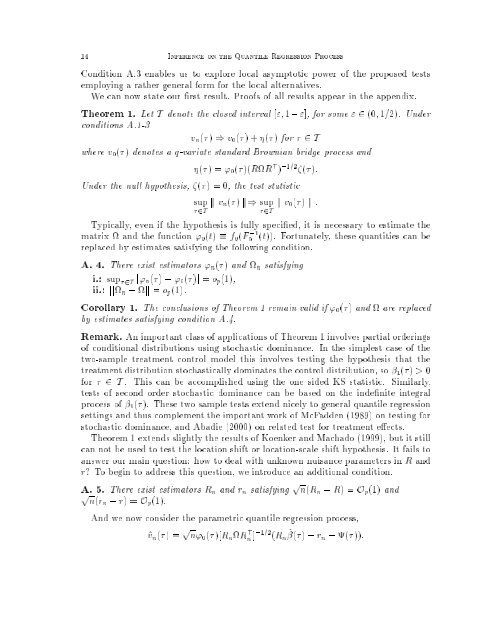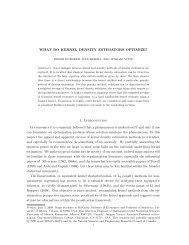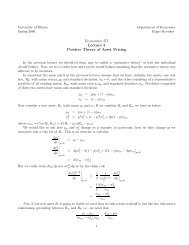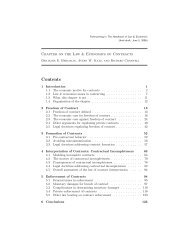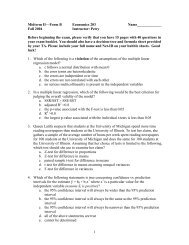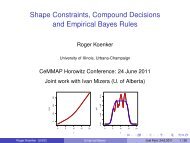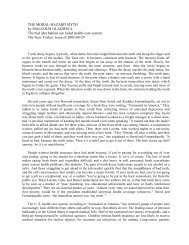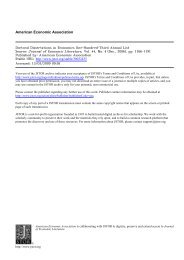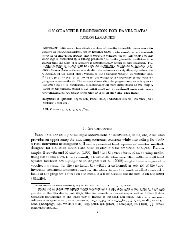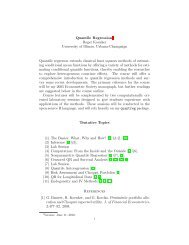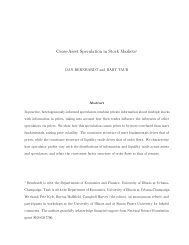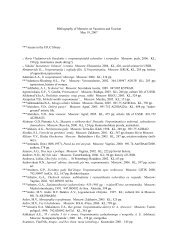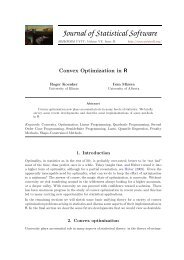1. Introduction - Econometrics at Illinois - University of Illinois at ...
1. Introduction - Econometrics at Illinois - University of Illinois at ...
1. Introduction - Econometrics at Illinois - University of Illinois at ...
Create successful ePaper yourself
Turn your PDF publications into a flip-book with our unique Google optimized e-Paper software.
14 Inference on the Quantile Regression ProcessCondition A.3 enables us to explore local asymptotic power <strong>of</strong> the proposed testsemploying a r<strong>at</strong>her general form for the local altern<strong>at</strong>ives.We can now st<strong>at</strong>e our rst result. Pro<strong>of</strong>s <strong>of</strong> all results appear in the appendix.Theorem <strong>1.</strong> Let T denote the closed interval ["; 1,"], for some " 2 (0; 1=2). Underconditions A.1-3v n () ) v 0 ()+() for 2Twhere v 0 () denotes a q-vari<strong>at</strong>e standard Brownian bridge process and() =' 0 ()(RR > ) ,1=2 ():Under the null hypothesis, () =0, the test st<strong>at</strong>isticsup2Tk v n () k) sup2Tk v 0 () k :Typically, even if the hypothesis is fully specied, it is necessary to estim<strong>at</strong>e them<strong>at</strong>rix and the function ' 0 (t) f 0 (F ,10(t)). Fortun<strong>at</strong>ely, these quantities can bereplaced by estim<strong>at</strong>es s<strong>at</strong>isfying the following condition.A. 4. There exist estim<strong>at</strong>ors ' n () and n s<strong>at</strong>isfyingi.: sup 2T j' n () , ' 0 ()j = o p (1),ii.: jj n , jj = o p (1).Corollary <strong>1.</strong> The conclusions <strong>of</strong> Theorem 1 remain valid if ' 0 () and are replacedby estim<strong>at</strong>es s<strong>at</strong>isfying condition A.4.Remark. An important class <strong>of</strong> applic<strong>at</strong>ions <strong>of</strong> Theorem 1 involves partial orderings<strong>of</strong> conditional distributions using stochastic dominance. In the simplest case <strong>of</strong> thetwo-sample tre<strong>at</strong>ment control model this involves testing the hypothesis th<strong>at</strong> thetre<strong>at</strong>ment distribution stochastically domin<strong>at</strong>es the control distribution, so 1 () > 0for 2T. This can be accomplished using the one sided KS st<strong>at</strong>istic. Similarly,tests <strong>of</strong> second order stochastic dominance can be based on the indenite integralprocess <strong>of</strong> 1 (). These two sample tests extend nicely to general quantile regressionsettings and thus complement the important work <strong>of</strong> McFadden (1989) on testing forstochastic dominance, and Abadie (2000) on rel<strong>at</strong>ed test for tre<strong>at</strong>ment eects.Theorem 1 extends slightly the results <strong>of</strong> Koenker and Machado (1999), but it stillcan not be used to test the loc<strong>at</strong>ion shift or loc<strong>at</strong>ion-scale shift hypothesis. It fails toanswer our main question: how to deal with unknown nuisance parameters in R andr? To begin to address this question, we introduce an additional condition.A. 5. There exist estim<strong>at</strong>ors R n and r n s<strong>at</strong>isfying p n(R n , R) =O p (1) andpn(rn , r) =O p (1):And we now consider the parametric quantile regression process,^v n () = p n' 0 ()[R n R > n ],1=2 (R n ^() , rn , ()):


